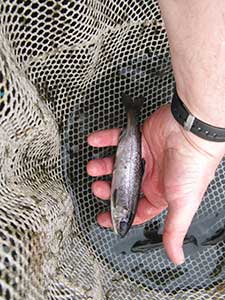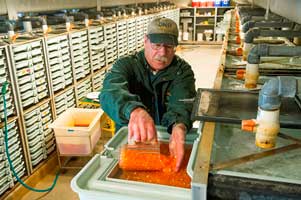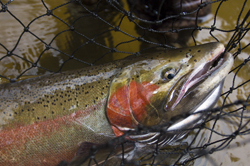- Details
By Louie Stout
 Indiana has begun stocking larger-than-normal coho into the St. Joseph River. (DNR photo)If you normally wait until April to start hitting the St. Joseph River for steelhead, you might want to expedite those plans.
Indiana has begun stocking larger-than-normal coho into the St. Joseph River. (DNR photo)If you normally wait until April to start hitting the St. Joseph River for steelhead, you might want to expedite those plans.
The mild March weather has drawn hundreds of fresh fish into the South Bend/Mishawaka area and river conditions have been favorable for fishing.
“It’s been a good March,” said Lake Michigan biologist Brian Breidert. “We typically don’t see this kind of push of steelhead until April.”
Nearly 3,500 steelhead have been counted at the South Bend fish ladder since Jan. 1. The biggest push came from March 17 to March 23 when nearly 1,200 fish moved up river.
- Details
(Provided by Michigan DNR)
 Salmon EggsSome years back, when Michigan's Chinook salmon program was in its greatest glory, some anglers suggested the Department of Natural Resources abandon raising the smaller, less spectacular coho salmon and put more emphasis on the kings. The DNR demurred, preferring a multispecies approach.
Salmon EggsSome years back, when Michigan's Chinook salmon program was in its greatest glory, some anglers suggested the Department of Natural Resources abandon raising the smaller, less spectacular coho salmon and put more emphasis on the kings. The DNR demurred, preferring a multispecies approach.
It appears to have been a wise strategy; Chinook salmon populations are down significantly, largely because of stocking cuts necessitated by a diminishing alewife population in Lake Michigan.
Chinooks depend almost entirely on alewives for their diet. Cohos are more adaptable. As a result, the coho population remains strong. It helped fill out the catch this past summer, as there were fewer Chinooks available to anglers.
Now, the DNR stocks nearly as many coho salmon as Chinooks. A decade ago, it was a quarter as many.
None of this was lost with the DNR crew this fall as they took coho eggs at Platte River State Fish Hatchery near Honor.
"This is the birthplace of Michigan salmon, the only coho salmon facility we have," said Aaron Switzer, the supervisor for all three of the northern Lower Peninsula's fish hatcheries. "This is where we put them when they first came here, this is where we get the best returns, and this is the best place for a rearing facility.
- Details
By Louie Stout
 Trout/salmon returns have biologists concerned.Some weird stuff is going on with trout and salmon this fall and St. Joseph River anglers are likely to suffer from it.
Trout/salmon returns have biologists concerned.Some weird stuff is going on with trout and salmon this fall and St. Joseph River anglers are likely to suffer from it.
Biologists are deeply concerned. If you’ve been fishing for steelhead, you probably are, too. Only 632 Skamania steelhead have passed through the South Bend ladder. And they are puny.
The problem isn’t just here, but lake-wide for most salmonids.
King salmon, for example, are almost non-existent in rivers and streams. Indiana usually relies on Michigan kings for brood stock, but the return has been so bad up there that Hoosier fish managers had to drive to Wisconsin to get what they could.
“It’s the worse fall run I’ve seen in 25 years,” said Bodine Assistant Hatchery Manager Bob Bell. “It’s a very, very bad situation that we hope will turn around.”
- Details
(Provided by Michigan DNR)
 No changes for chumming and steelhead bag limit regulations.Michigan's fisheries staff recently discussed with the public restrictions on the amount of organic material that could be used as chum and a reduced steelhead possession limit on four West Michigan rivers.
No changes for chumming and steelhead bag limit regulations.Michigan's fisheries staff recently discussed with the public restrictions on the amount of organic material that could be used as chum and a reduced steelhead possession limit on four West Michigan rivers.
Seven meetings were held across the state in July with approximately 275 participants in attendance. Comments also were received through phone and email.
The discussions were initiated after the DNR received requests from anglers and constituent groups to lower the steelhead possession limit on the Muskegon, Pere Marquette, Little Manistee and Big Manistee rivers. A three-fish daily possession limit for steelhead has been in place since 1989. Michigan boasts some of the best river steelhead fishing in the country.
Angler interviews conducted on these four rivers in the past indicated only 5 percent of anglers fishing for steelhead harvest the three-fish daily possession limit.
The DNR also recently received complaints related to excessive use of chum on select Lake Michigan rivers, especially the Muskegon River. The concern stems from lower catch rates for those who do not use chum.
The DNR does not consider chumming as a biological threat to fish populations in general.
"Based on our current understanding of these two specific issues, we do not recommend any regulatory changes at this time," said Nick Popoff, manager of the DNR's Aquatic Species and Regulatory Affairs Unit. "We appreciate the public's feedback regarding chumming and steelhead possession limits, as it helped us better understand angler concern related to these two issues and this conversation will undoubtedly continue."
- Details
It’s been a tough year for Lake Michigan anglers, and based on a recent conversation with Michigan fisheries biologist Jay Wesley, the fishery continues to deal with ecological changes that could affect future fishing.
Most anglers know, and Wesley acknowledged, that the king salmon population is lower than it’s been since the late 1980s. That impact was really felt this year.
It was done by design, since Michigan and other states slashed stocking rates two years ago in an attempt to reduce pressure on a diminishing alewife forage base.
Fish Mangers use stocking rates to maintain a balance between game fish and the forage base. That got out of whack when they discovered a few years ago that there was more natural reproduction in king salmon than previously realized. That was putting more mouths in the lake than the forage could support.
In fact, studies show that the natural reproduction of kings has dropped by as much as 14 percent since the stocking numbers have been reduced.
“That’s a good thing because it is giving our forage a chance to rebound,” said Wesley. “I’m optimistic the alewives will come back. We’re doing an assessment this fall to see how the 2015 alewife population is doing.”





